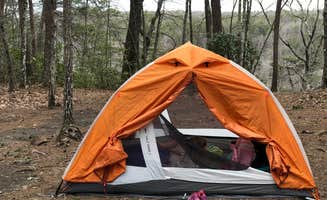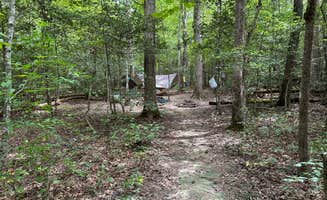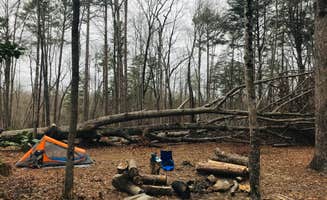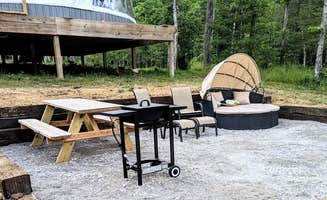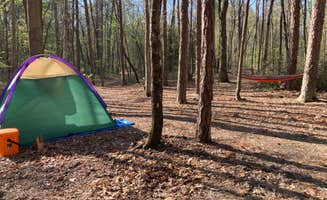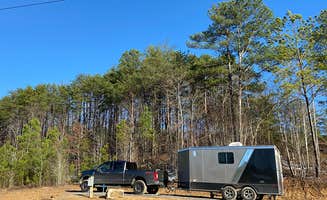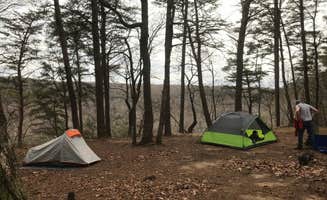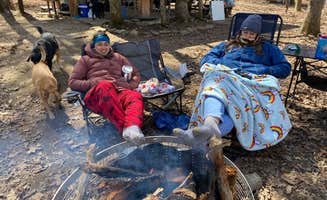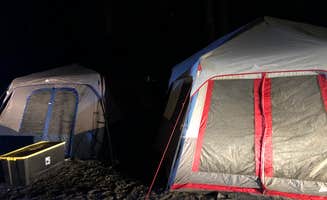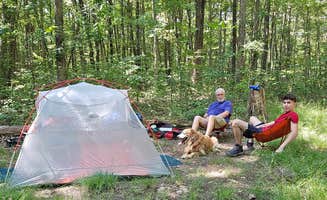The Cumberland Plateau area near Palmer, Tennessee sits between 1,800-1,900 feet elevation, creating a distinctively cooler microclimate that averages 5-10 degrees below surrounding lowlands. Campers often encounter early morning fog that lifts by mid-morning in the numerous gorges and valleys. The region's plateau formations create natural wind tunnels that provide welcome relief during summer's high humidity.
What to do
Waterfall swimming: 2-mile hike from Savage Falls Campground to access multiple swimming locations in the gorge. "There is a big parking area but it can fill up fast with those that are day hiking to see the falls. It's not a tough hike to the campsite or to the falls themselves," notes Brittni F., who recommends allowing 4-5 hours for swimming and exploration.
Spelunking tours: $15.95 per adult at Raccoon Mountain Caverns where guided tours run hourly from 9am-5pm. "Crystal Cave was right on site and enjoyed the guided tour. (Advanced reservations are required.) We also loved the guided tour just down the road at Ruby Falls," shares Jen O., who visited with family in 2021.
Multi-day hiking: 10+ miles of connected trails from Stone Door to Greeter Falls via Big Creek Gulf Trail. "We hiked down 'Fiery Gizzard' and it was an easy ten-mile hike to our site, perfect for beginners and kids. I especially love this place in the Fall!" recommends Phoebe A., who completed the trek with family members of varying abilities.
What campers like
Private camping spots: Alum Gap Campground offers backcountry sites with spacing that provides natural sound barriers. "Most of the sites are large, with lots of space to set up camp and hang out, and they're far enough apart to maintain a decent amount of privacy," notes Brittany S., who found it ideal for first-time backpackers.
Natural swimming holes: Multiple locations throughout South Cumberland State Park provide cooling relief during summer months. "You can hear the river at night when all is quiet and the campground was very spacious," writes CASEY W. about the Father Adamz campground area, adding that "it was breathtaking" after the half-mile hike in.
Year-round accessibility: Fall Creek Falls State Park maintains facilities throughout winter when many other locations close amenities. "What a great State Park. Hiking. Bike Riding. Golfing. Can go on and on. Campground A & B are great for families with kids. C&D are more quiet," explains Richard F., who noted the upgraded dump station with six dumps all on asphalt.
What you should know
Cell service limitations: Signal is generally strongest on plateau tops but becomes increasingly unreliable in gorges. "I have Verizon and had 3 bars and LTE and the data signal was strong for me. Was able to stream, FaceTime, pretty much whatever I wanted," reported Thomas H. about Greeter Falls Campground, though coverage varies significantly by location.
Water availability challenges: Many backcountry sites require filtration or carrying water in. "There is a small stream nearby (just make sure you have a water purifier!)" advises Brittany S. about the Alum Gap area, while another camper noted that "depending on recent rainfall, you might need to collect water back at the Greeter Falls area."
Reservation requirements: Most developed sites fill quickly, especially during peak seasons. "Book ahead of time as campsites fill up quickly on weekends!" recommends Aaron S. about Stone Door Campground, while another camper mentioned making reservations 148 days in advance for Fall Creek Falls.
Tips for camping with families
Choose appropriate campground loops: Different areas cater to various family needs with significantly different noise levels and amenities. "Campground A & B are great for families with kids. C&D are more quiet. Pay attention to grades of sites when booking, you might need extra supports to level out," advises a Fall Creek Falls visitor.
Beginner backpacking routes: Stone Door Campground provides an ideal introduction for families new to backcountry camping. "Our family camped here about 2 years ago as our first camping trip together. It was perfect. We love how much space and privacy we had and will be a regular camping trip for us," shares Robbie M., noting its accessibility while offering a backcountry experience for young children.
Swimming alternatives: During drier seasons when waterfalls may not be flowing, some campgrounds provide additional options. "The park itself has a scenic loop drive of the gorge, multiple waterfalls to visit, miles on end of hiking trails in which some cross rope bridges, awesome swimming holes, and even an olympic pool with diving boards and a snack shack for the kiddos," explains Brandie D. at Fall Creek Falls.
Tips from RVers
Site leveling challenges: Many RV sites in the region require additional equipment for proper setup. "Our rv sites were gravel, required some leveling, had FHUs. 50/30/20 amp service, water and sewer of course," notes Thomas H. about his stay at Greeter Falls Campground.
Size restrictions: Larger rigs face limitations at many campgrounds. "We have a 40' class A and flat tow a Jeep. We stayed in site 203 for 3 nights. While we really enjoyed the campground, this site was not ideal for an RV our size. We weren't able to put our awnings out or comfortably sit outside," shares Jen O. about Raccoon Mountain, suggesting site 226 might work better for larger rigs.
Arrival timing: Several campgrounds have challenging arrival logistics after dark. "Arrived in the dark, do not recommend as there are not much lighting to see especially if the site is tight with others," warns Richard F. about Fall Creek Falls, adding that the upgraded dump station includes six dumps all on asphalt.


